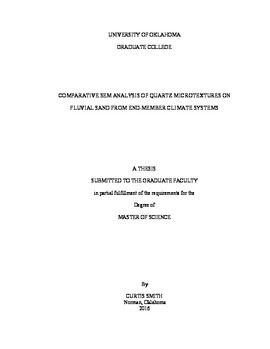| dc.description.abstract | Microtextural analyses of sedimentary quartz grains are increasingly used as a paleoenvironmental proxy, as particular microtextures have been proposed to reflect processes unique to particular environmental or climatic conditions. However, little consensus exists on which microtextures may be unique to a particular weathering process, and what types of quantitative approaches are needed to use this approach for paleoclimate reconstruction. This study documents microtextures on fluvial quartz grains collected in modern end-member climates (with respect to precipitation and temperature) to assess whether climate imparts unique microtextures (or suites of microtextures) potentially useful for interpreting paleoclimate. To isolate climate as the primary variable, other attributes such as bedrock lithology, transect length, and drainage basin size, were controlled to the degree possible in an empirical comparison. Presence of 17 microtextures on first-cycle quartz from fluvial systems in Puerto Rico (hot-humid), Norway (cold-humid-proglacial), California (hot-arid), and Peru (cold- semiarid-proglacial), was documented under double-blind conditions, and results analyzed using principal component analysis (PCA). Results from PCA, combined with univariate analysis results, were used to construct a ternary diagram to enable visual comparison of large datasets. Humid and arid climates are statistically distinct on the basis primarily of common precipitation features and secondarily, v-shaped percussion fractures, the former caused by enhanced chemical weathering and the latter by fluvial saltation. Grains from arid climates exhibit a larger incidence of upturned plates, interpreted to reflect the influence of high-stress aeolian saltation on grains that subsequently undergo fluvial entrainment. Grains from proglacial systems exhibit a
x
higher incidence of fracture faces, possibly attributable to the effects of both freeze- thaw weathering and glacial crushing. However, with the exceptions of the humid-arid distinction, differences in microtextural suites are subtle. These results suggest that quartz microtextural analysis holds some promise for aiding paleoclimatic interpretations for coarse-grained fluvial strata, but additional research is needed to assess whether additional methodological approaches to grain analyses and/or statistical techniques could further strengthen climatic differentiation. | en_US |
